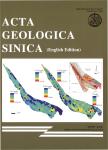Source and Enrichment Mechanism of Lithium in the Triassic Argillaceous Marine Sediments from Huangjinkou, Sichuan, China
Source and Enrichment Mechanism of Lithium in the Triassic Argillaceous Marine Sediments from Huangjinkou, Sichuan, China作者机构:Key Laboratory of Metallogeny and Mineral AssessmentMinistry of Natural ResourcesInstitute of Mineral ResourcesChinese Academy of Geological SciencesBeijing 100037China School of Earth Science and ResourcesChina University of GeosciencesBeijing 100083China The 405 Geological TeamSichuan Province Geology and Mineral Exploration and Development BureauDujiangyanSichuan 611830China
出 版 物:《Acta Geologica Sinica(English Edition)》 (地质学报(英文版))
年 卷 期:2022年第96卷第2期
页 面:536-545页
核心收录:
学科分类:081803[工学-地质工程] 08[工学] 0708[理学-地球物理学] 0818[工学-地质资源与地质工程]
基 金:the National Key Research and Development Project of China(Grant Nos.2017YFC 0602705,2017YFC0602704,2017YFC0602701) the China Geological Survey(Grant No.DD20160055) National Social Science Fund of China(Grant No.19ZDA111)
主 题:lithium argillaceous marine sediments clay Triassic Xuanhan salt basin
摘 要:In the Triassic marine sediments, an obvious enrichment of lithium has been found. The source and enrichment mechanism of lithium is unknown. Here, we report trace and rare earth element and isotope analyses for Triassic sedimentary samples from core ZK601, recovered from the Huangjinkou anticline in the Xuanhan basin. Lithium concentrations from the Leikoupo and Jialingjiang formations are much higher than the average concentrations in the crust of eastern China and in other marine sediments. Lithium concentrations are highest at depths of 3300–3360 m(in argillaceous marine sediments), and Li is positively correlated with Rb, Ga, Zr, Nb and other trace elements. The range of δ^(7)Li values in our samples is consistent with that in other Triassic marine carbonate rocks. Lithium concentrations and isotope ratios are negatively correlated in the argillaceous dolomite samples at depths of 3300–3360 m. We compared the results in this study with trace and rare earth elements in the clay from Sichuan and Chongqing, and propose that the clay in the argillaceous marine evaporites from Huangjinkou formed via the hydrolysis of volcanic ash during Early–Middle Triassic volcanic eruptions into brine basins, during which clay adsorbed Li from the brine and formed Li-rich argillaceous dolomites. The addition and hydrolysis of volcanic ash in the evaporative brine is also related to the formation of a new type of polyhalite.



